Channel Allocation for Burst Transmission to a Diversity of Satellites
a satellite and channel allocation technology, applied in the field of channel allocation for burst transmission to a diversity of satellites, can solve the problems of affecting the service quality of the system, affecting the reception probability of one or both of these transmissions, and unable to be ignored, so as to improve the system capacity and/or quality of servi
- Summary
- Abstract
- Description
- Claims
- Application Information
AI Technical Summary
Benefits of technology
Problems solved by technology
Method used
Image
Examples
Embodiment Construction
[0066]The invention will now be described with respect to various embodiments. The following description provides specific details for a thorough understanding of, and enabling description for, these embodiments of the invention. However, one skilled in the art will understand that the invention may be practiced without these details. In other instances, well-known structures and functions have not been shown or described in detail to avoid unnecessarily obscuring the description of the embodiments of the invention.
[0067]The invention is directed to a method for allocating transmission channels to a plurality of devices configured to communicate with a diversity of satellites, comprising, at each device, the steps of:
a) determining the current time and self location via a Global Navigation Satellite System (GNSS);
b) determining the current service areas (“footprints”) of said diversity of satellites on earth surface;
c) defining as a mega-cell each intersection of footprints which is...
PUM
 Login to View More
Login to View More Abstract
Description
Claims
Application Information
 Login to View More
Login to View More - R&D
- Intellectual Property
- Life Sciences
- Materials
- Tech Scout
- Unparalleled Data Quality
- Higher Quality Content
- 60% Fewer Hallucinations
Browse by: Latest US Patents, China's latest patents, Technical Efficacy Thesaurus, Application Domain, Technology Topic, Popular Technical Reports.
© 2025 PatSnap. All rights reserved.Legal|Privacy policy|Modern Slavery Act Transparency Statement|Sitemap|About US| Contact US: help@patsnap.com



